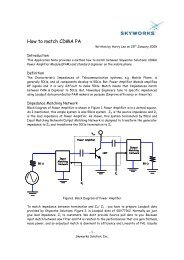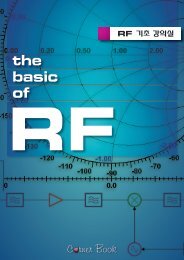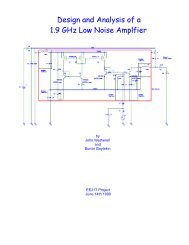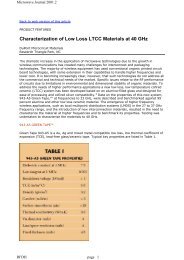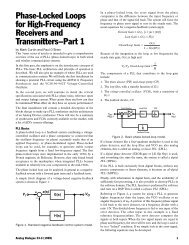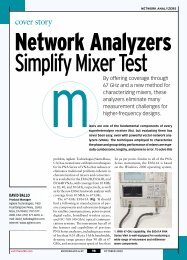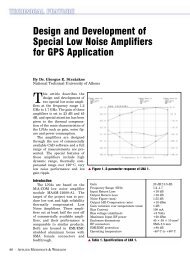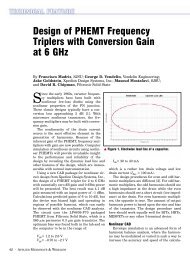Unfiltered FQPSK: Another Interpretation and Further Enhancements
Unfiltered FQPSK: Another Interpretation and Further Enhancements
Unfiltered FQPSK: Another Interpretation and Further Enhancements
You also want an ePaper? Increase the reach of your titles
YUMPU automatically turns print PDFs into web optimized ePapers that Google loves.
that occur along this pair of paths, we have<br />
2 Ts<br />
/ 2<br />
2<br />
2<br />
dmin = ∫ [( s t s t s t s t<br />
Ts<br />
/ 3() − ()) + ( () − ())<br />
− 2<br />
3<br />
4 5<br />
(14)<br />
2<br />
2<br />
+ ( s () t −s () t s () t s () t<br />
2 14 ) + ( −<br />
0 3 )<br />
2<br />
2<br />
+ s() t −s () t s () t s () t ] dt<br />
Evaluation of the squared Euclidean distances<br />
between the pairs of waveforms<br />
required in (14) using (7a) <strong>and</strong> (7b) for their<br />
definition results after much algebra in<br />
d<br />
( ) + ( − )<br />
(15)<br />
The average signal (I+Q) energy is obtained<br />
from<br />
1 15 15<br />
Ts<br />
/ 2 2<br />
2<br />
Eav<br />
= ∑ ∑ ∫ [ si<br />
( t) + s t dt<br />
Ts<br />
i<br />
( )] =<br />
− / 2<br />
256 i=<br />
0 j=<br />
0<br />
⎡<br />
Ts<br />
⎤<br />
Ts<br />
2 1 15<br />
∑ ∫ si<br />
t dt s t dt<br />
Ts<br />
Ts<br />
i<br />
⎣<br />
⎢<br />
i<br />
⎦<br />
⎥ = 1 7<br />
/ 2 2<br />
/ 2 2<br />
()<br />
− 2<br />
∑ ∫ ()<br />
/<br />
− / 2<br />
16 = 0<br />
4 i=<br />
0<br />
which again using (7a) <strong>and</strong> (7b) evaluates to<br />
E<br />
(16)<br />
(17)<br />
Since the average signal (symbol) energy is twice the<br />
average energy per bit, then the normalized minimum<br />
squared Euclidean distance for the paths corresponding<br />
to starting <strong>and</strong> ending in the same state is<br />
2<br />
d<br />
2E<br />
1 5<br />
⎡7<br />
8 ⎛ 3 4 ⎞<br />
− − A +<br />
4 3 ⎝ 2 3 ⎠ + ⎤<br />
⎢ π π ⎥<br />
= ⎢<br />
⎥T<br />
=<br />
s<br />
1 552Ts<br />
⎢<br />
2⎛11<br />
4⎞<br />
⎥<br />
⎢ A +<br />
⎣ ⎝ 4 π ⎠ ⎥<br />
⎦<br />
2<br />
.<br />
min<br />
b<br />
12 14<br />
⎛<br />
2<br />
7+ 2A+<br />
15A ⎞<br />
= ⎜<br />
⎟ T = 0.<br />
9946 T<br />
⎝ 16 ⎠<br />
av s s<br />
⎡<br />
2<br />
16 7 8 ⎛ 3 4 ⎞ 11 4<br />
− − A + A<br />
4 3 ⎝ 2 3 ⎠ + ⎛<br />
4<br />
+ ⎞⎤<br />
⎢<br />
=<br />
⎣ π π ⎝ π⎠⎥<br />
⎦<br />
= 156<br />
2<br />
7+ 2A+<br />
15A<br />
min<br />
.<br />
( )<br />
(18)<br />
▲ Figure 11. The optimum trellis-coded receiver for <strong>FQPSK</strong>.<br />
Upon examination of all length 3 error event paths<br />
that begin in one state <strong>and</strong> end in another, e.g., Figures<br />
10a <strong>and</strong> 10b, no pair of paths with smaller normalized<br />
minimum squared Euclidean distance was found.<br />
<strong>Further</strong>more, by exhaustive search, it can be shown<br />
that the minimum squared Euclidean distance of (18) is<br />
the smallest over all pairs of paths that start in any state<br />
<strong>and</strong> end in any state regardless of the length of the path.<br />
Thus, the normalized minimum squared Euclidean distance<br />
for the <strong>FQPSK</strong> scheme is given by (18).<br />
For the spectrally enhanced <strong>FQPSK</strong> using the waveforms<br />
of (9) as replacements for their equivalents in<br />
(7b), the minimum squared Euclidean distance over all<br />
length 3 trellis paths occurs, for example, between the<br />
first <strong>and</strong> second paths, starting <strong>and</strong> ending in state<br />
“0000” <strong>and</strong> is given by (see Figure 9a)<br />
2 Ts<br />
/<br />
dmin = ∫ [ s t s t s t s t<br />
Ts<br />
/ 0( ) −<br />
1( ) + ( ) − ( )<br />
− 2<br />
0 12<br />
2<br />
2<br />
+ s () t −s () t s () t s () t<br />
+ s () t −s () t s () t s () t ] dt<br />
(19)<br />
Once again, evaluation of the squared Euclidean distances<br />
between the pairs of waveforms required in (19)<br />
using (7a) <strong>and</strong> (7b) together (now with (9) for their definition)<br />
results after much algebra in<br />
d<br />
Likewise, the average signal energy is now<br />
E<br />
2 2<br />
( ) ( )<br />
( ) + ( − )<br />
2<br />
( )<br />
0 3<br />
0 4<br />
2<br />
( 0 2 ) + −<br />
0 0<br />
(20)<br />
(21)<br />
Thus, the normalized minimum squared Euclidean<br />
distance is<br />
d<br />
2E<br />
2<br />
⎡3− 6A+<br />
15A ⎤<br />
= ⎢<br />
T 1 564<br />
s T<br />
s<br />
⎣ 4<br />
⎥ =<br />
⎦<br />
2<br />
min<br />
.<br />
⎛ 21 8 ⎛ 1 8 ⎞ 29<br />
− − A⎜<br />
− ⎟ + A<br />
⎜ 8 3π<br />
⎝ 4 3π⎠<br />
8<br />
⎜<br />
4<br />
⎜<br />
⎝<br />
3− 6A+<br />
15A<br />
= 156<br />
8 ⎛ 1 8 ⎞ 29 2<br />
− − A − A<br />
3π ⎝ 4 3π⎠ + 8<br />
2 2<br />
min<br />
=<br />
.<br />
b<br />
21<br />
8<br />
( )<br />
⎞<br />
⎟<br />
⎟T<br />
⎟<br />
⎠<br />
= 1.<br />
003T<br />
av s s<br />
2<br />
2<br />
(22)<br />
90 · APPLIED MICROWAVE & WIRELESS






